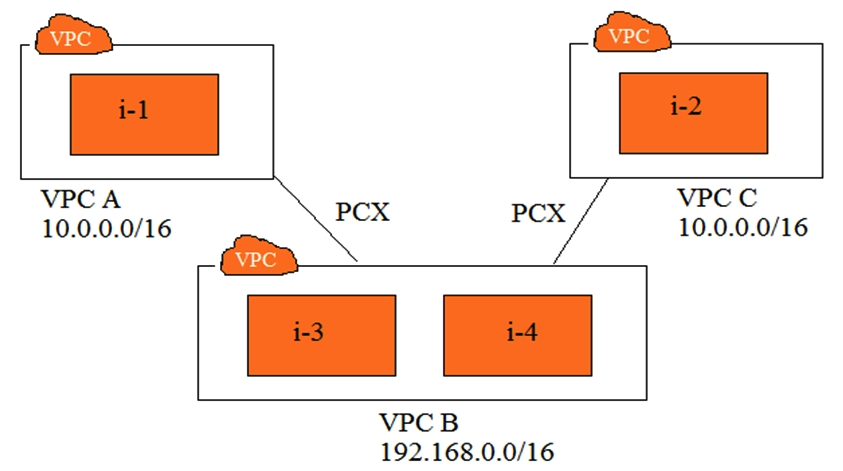Multiple Choice
Refer to the image.  You have three VPCs: A, B, and C. VPCs A and C are both peered with VPC B. The IP address ranges are as follows: VPC A: 10.0.0.0/16 VPC B: 192.168.0.0/16 VPC C: 10.0.0.0/16 Instance i-1 in VPC A has the IP address 10.0.0.10. Instance i-2 in VPC C has the IP address 10.0.0.10. Instances i-3 and i-4 in VPC B have the IP addresses 192.168.1.10 and 192.168.1.20, respectively, i-3 and i-4 are in the subnet 192.168.1.0/24. i-3 must be able to communicate with i-1 i-4 must be able to communicate with i-2 i-3 and i-4 are able to communicate with i-1, but not with i-2. Which two steps will fix this problem? (Choose two.)
You have three VPCs: A, B, and C. VPCs A and C are both peered with VPC B. The IP address ranges are as follows: VPC A: 10.0.0.0/16 VPC B: 192.168.0.0/16 VPC C: 10.0.0.0/16 Instance i-1 in VPC A has the IP address 10.0.0.10. Instance i-2 in VPC C has the IP address 10.0.0.10. Instances i-3 and i-4 in VPC B have the IP addresses 192.168.1.10 and 192.168.1.20, respectively, i-3 and i-4 are in the subnet 192.168.1.0/24. i-3 must be able to communicate with i-1 i-4 must be able to communicate with i-2 i-3 and i-4 are able to communicate with i-1, but not with i-2. Which two steps will fix this problem? (Choose two.)
A) Create subnets 192.168.1.0/28 and 192.168.1.16/28. Move i-3 and i-4 to these subnets, respectively.
B) Create subnets 192.168.1.0/27 and 192.168.1.16/27. Move i-3 and i-4 to these subnets, respectively.
C) Change the IP address of i-2 to 10.0.0.100. Assign it an elastic IP address.
D) Create a new route table for VPC B, with unique route entries for destination VPC A and destination VPC C.
E) Create two route tables: one with a route for destination VPC A, and another for destination VPC C.
Correct Answer:

Verified
Correct Answer:
Verified
Q114: You are under a DDoS attack and
Q115: An organization will be extending its existing
Q116: A company has an application running on
Q117: What is the minimum number of subnets
Q118: Your Amazon Kinesis application receives data streams
Q120: A company is deploying a critical application
Q121: A user is having data generated randomly
Q122: An organization with a growing e-commerce presence
Q123: A Network Engineer needs to be automatically
Q124: You have just deployed a website that